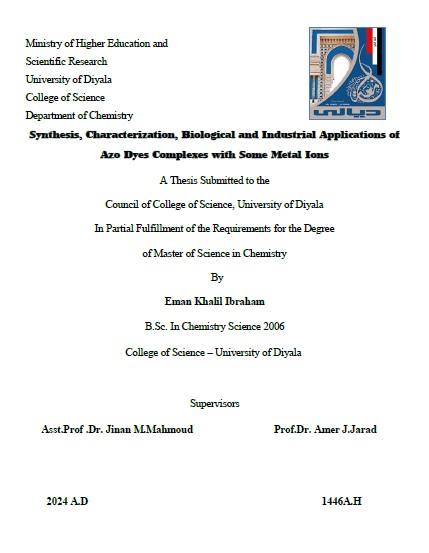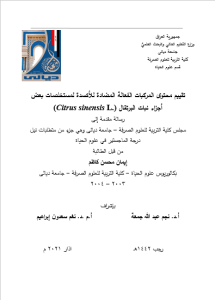Abstract
In this research, the synthesized compounds were divided into two parts:
The first part included new azo ligands )L1,L2) have been produced all resting on the Luminol as a backbone of the prepared ligands having the following structures.
L1=
L2=
Scheme (1): General scheme of the synthesized compounds
Produced azo ligands have been characterized by (FT-IR ,1H-13C NMR –NMR, UV-Vis and LC-Mass ) spectra and (C.H.N.O) analysis.
The second part of this project refers to the synthesis of metal chelates CoII , NiII, CuII,Pd II and PtIV with two prepared azo ligands . All production was performed after fixing the ideal pH and molar concentration that obeyed Lambert –Beers law in the studies pH rates. According to the molar ratio methods- the structure of these metal chelates was deduced depending on the spectroscopic studies of the complex solution of the above ions. However, ratio of 1:2 M:L for CoII, NiII ,CuII,Pt IV ions were obtained . The mole ratio of Pd II complex was 1:1 M:L . FT-IR, UV-Vis spectra, conductivity, magnetic susceptibility and melting points measurements were used to characterize prepared complexes.
the Flame atomic absorption technique has been measured to calculate the percentage of the metals in the complexes. (C.H.N.O) analysis were also found, and the results are in agreement with the calculated values.
All the complexes are quite stable and could be stored for months without any appreciable change. Depending on the results obtained by elemental and spectral analysis , an octahedral structure is suggested for CoII ,NiII , CuII , Pt IV complexes .and square Planar for the PdII complex .
In addition the dyeing performance of the produced compound has been assessed on cotton fabric , the dyes were tested for light and detergent fastness .
Finally evaluation of biological activities for ligands L1 and L2 and its complexes on Mitotic Index(chromosome) in lymphocytes of humans . the compounds were compared with the colchicine . Show the L1 pd complex was the highest inhibition rate was recorded as 3.97d ± 0.02 at aconcentration of 100 mg\ml than to the L1 and L1 pt. while the ligand L2 recorded the highest inhibition rate at 3.78 d±0.02 at aconcentration of 100 mg\ml than to the its complexes .




